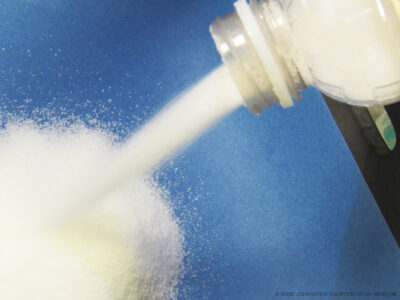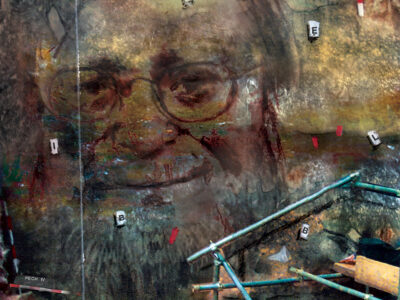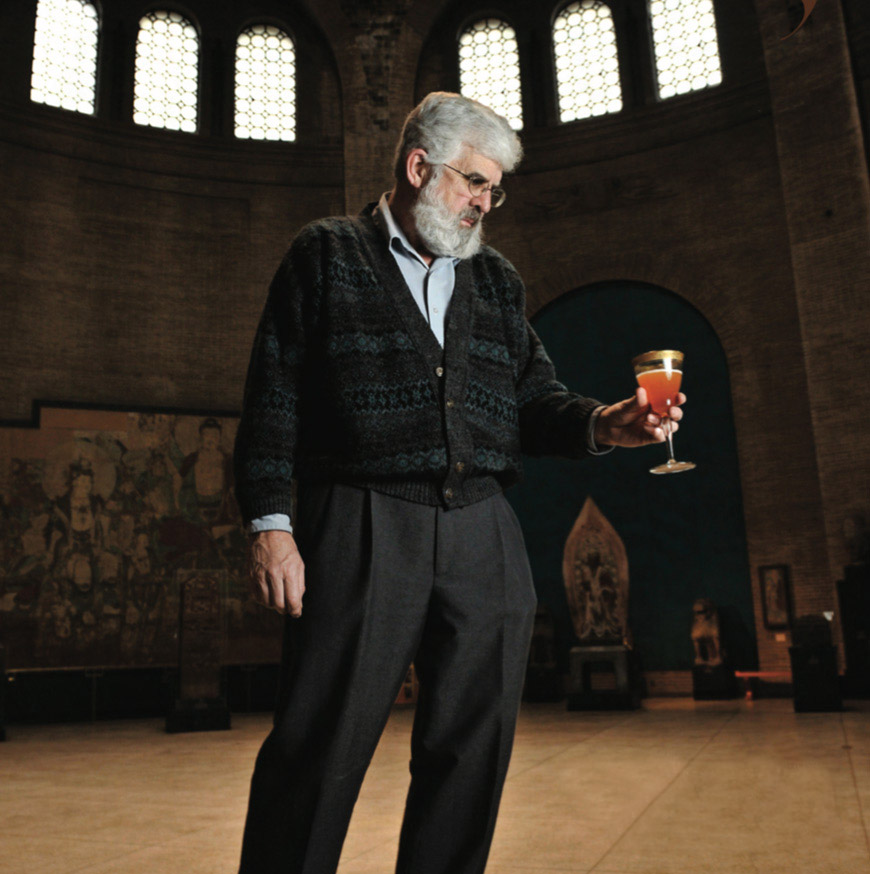
Biomolecular archaeologist and Penn Museum researcher Patrick McGovern Gr’80 has found some of the oldest alcoholic beverages known to history, and he wants you to take a glug. They might just be responsible for civilization as we know it. (Not to mention your next hangover.)
By Trey Popp | Photography by Candace diCarlo
Excerpt | From Drunken Monkeys to Medicine Men: A Brief History of Tipsiness
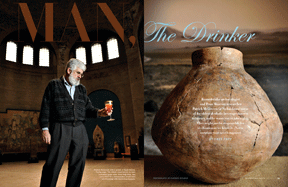
The scrum around Sam Calagione’s keg measured 10 deep, and everyone was angling for a cup laced with the brewer’s saliva. It was not a secret ingredient. The drinkers had just heard all about it in the Penn Museum’s Upper Egyptian Gallery. They’d seen slides. But for fans of extreme fermentation, this was the highlight of the night: the final few liters of a very limited edition inspired by a theory of the invention of beer itself.
Calagione is the founder of Delaware’s Dogfish Head Brewery. A trim and tanned 40-year-old with the jaw line of a Gillette model and a ready laugh, he doesn’t seem like someone who would spit in your drink. But then neither does Patrick McGovern Gr’80, who had provided the scholarly justification for it. The mild-mannered archaeologist is a picture of harmlessness. His flaring white beard and snowdrift of hair make him look like a man poking his spectacles through a pile of wool. Yet there was no getting around it. This brew contained “six or seven hours’ worth” of his own saliva as well.
McGovern, the scientific director of the Biomolecular Archaeology Laboratory for Cuisine, Fermented Beverages, and Health at the Penn Museum, has spent the last two decades on the trail of ancient wines and beers. Scraping the gunk out of old cauldrons and pottery sherds, he has found evidence of alcoholic beverages as far apart in space and time as Iron Age Turkey and Neolithic China. Some of his discoveries have been surprising. Some have been bizarre. Using tools like mass spectrometry and liquid chromatography, McGovern has deciphered, with unprecedented exactitude, the ingredients of fermented beverages brewed as far back as 9,000 years ago.
Calagione has helped him put some of that evidence to a literal taste-test. Together they have reverse-engineered four archaic grogs. Each started out as an academic exercise, but the project has taken on a commercial life of its own. Two have won medals at the Great American Beer Festival in Denver, Colorado. One, a mixed wine/beer/mead concoction reconstructed from McGovern’s analysis of a drinking set buried with the legendary King Midas circa 700 B.C., has won more awards than anything else Dogfish Head makes.
Tonight’s quaff, though, promised to make its predecessors look tame. It was a South American-style beer called chicha made with the help of Clark Erickson, associate curator of the Museum’s American section. To transform its base of purple Peruvian corn into a mash amenable to yeast fermentation, the men had chewed every last kernel and spit the cuds into the brewing kettle.
“We think that chewing is probably the earliest way that humans would have transformed starch into sugar” in order to get fermentation going, McGovern explained in his lecture. Modern beer relies on the enzymes released by sprouted and malted barley to get this job done, but malting barley can be a little tricky. Our saliva contains an enzyme called ptyalin that does the same thing. “It may not sound very appetizing to think of people preparing their beverages this way, but once you get an alcoholic beverage, it does kill off any harmful bacteria.”
He paused for a beat. “And it might add some special flavors, too. You never know.”
Well, not until you slug it down, anyway. Compared to the saffron-kissed honey of Dogfish Head’s Midas Touch, or the chili-tinged chocolate notes of its Maya- and Aztec-inspired Theobroma, the special flavors in the spit-primed Chicha ran more toward funky pink peppercorns with a hint of fraternity basement. But this particular vintage was an unlikely candidate for large-scale production to begin with. It would wear out too many jaws. For Calagione, a limited run ending at the Museum—which got the last remaining keg—was part of the fun. “When we opened in 1995,” he told the tasting crowd, “our goal was to brew the antithesis of what dominated the commercial brewing landscape then and now.”
That contrarian ethos practically leaps out of every bottle Dogfish Head caps, corks, or seals with a plastic screwtop (as in its semi-ironic 40-ounce Liquor De Malt, which came with a hand-stamped brown paper bag). The ones stemming from McGovern’s biomolecular assays, though, have a special significance for Calagione. To fans and critics alike, his brewery has a way of coming off like a high-school hooligan who’ll rip up any page with a rule printed on it. But working with “Doctor Pat,” as the brewer refers to his professorial partner, has strengthened Calagione’s conviction that Dogfish Head isn’t so much trampling on beer history as resurrecting the full breadth of it.
McGovern has his own reason to relish bringing tastes of the deep past to present-day tongues. He thinks our fondness for alcoholic beverages has been a profound force in human history. One of archaeology’s most fascinating unsettled questions concerns which foodstuff was more consequential in civilization’s early stages: bread or beer? With each ancient grog he has uncovered—particularly a 9,000-year-old specimen from China’s Yellow River Valley, which represents the earliest known alcoholic beverage—McGovern has added evidence to the tipplers’ side of the ledger. He believes the quest for fermented beverages was mankind’s primary motivation for domesticating grain-bearing plants. It isn’t his only conjecture. Once he gets rolling—even without the aid of one of his and Calagione’s left-field libations—McGovern can make alcohol seem like the master key that you can’t understand human culture without.
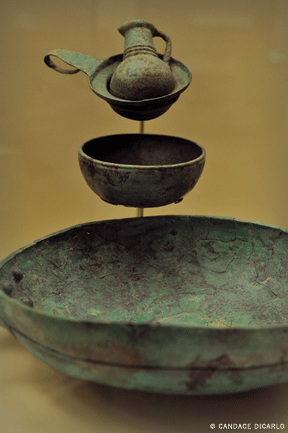
The Penn Museum’s Biomolecular Archaeology Lab is not a good place to come for a cup of coffee. For one thing, there’s the labyrinth. The jumble of narrow hallways, unsigned doors, and partial-story stairwells leading to McGovern’s headquarters would flummox a hedgerow-maze architect. But the main drawback is the scores of glass bottles with lables like ceric ammonium and potassium persulfate and pyrogallic acid that rattle softly when McGovern opens the glass-fronted cabinet they share with the coffee mugs.
These, though, are the tools of his trade. McGovern, who is also an adjunct professor of anthropology at Penn, has spent most of his career in focusing on a branch of chemistry most archaeologists—and even a lot of chemists—avoid.
“Archaeologists tend to stay on the inorganic side of things,” he says. “But the organic side is really what we are, much more, as human beings. So as more information becomes available about food and drink and so forth, I think archaeologists are getting more interested in feasting and drinking ceremonies, and how much importance they had to the development of human culture.”
Though McGovern has helped propel the Penn Museum to the forefront of what you might call the eat-drink-and-be-merry niche of archaeological research, the Museum has harbored interest in beer and wine for at least 25 years. In 1986, Penn anthropology professor Solomon Katz and Near East Section research specialist Mary Voigt published an influential article in the Museum’s journal, Expeditions, exploring the role of beer-making in the history of agriculture. Their thesis had its genesis in a question first posed by botanist Jonathan Sauer in the 1950s. Prompted by archaeologist Robert Braidwood’s seminal work on early food production in Jarmo, Iraq, which was considered one of the oldest agricultural communities in the world, Sauer wondered if bread was as important a part of the story there as most people assumed.
As Braidwood later relayed the query to his colleagues: “Could the discovery that a mash of fermented grains yielded a palatable and nutritious beverage have acted as a greater stimulant toward the experimental selection of a breeding of cereals than the discovery of flour and breadmaking?”
Katz and Voigt laid out a persuasive argument that, in terms of biocultural evolution, beer made an awful lot of sense.
“Suppose that the consumption of a food produced an altered state of awareness or consciousness that was noticeable, but that did not have serious toxic side effects,” they wrote. “Now suppose that this food also had a second, imperceptible effect, a substantial improvement in nutritional value over the unprocessed cereal grains. This is exactly what happens when barley and wheat are fermented into beer.”
Fermentation is a nutritional boon whether it’s used to raise a dough or produce beer. Among other benefits, yeast manufactures the important dietary protein lysine, and is an abundant source of B vitamins, which enhance immune- and nervous-system functioning. Alcohol has the additional advantage of killing bacteria in contaminated drinking water. Therefore, Katz and Voigt continued, “individuals and groups who consumed beer were better nourished than those who consumed wheat and barley as gruel”—which is probably the earliest way humans ate grains. “In biological terms, beer drinkers would have had a ‘selective advantage’ in the form of improved health for themselves and ultimately for their offspring.”
People do not, of course, change their behavior to reap an “imperceptible” advantage. But that’s where beer has something going for it that bread does not: the ability to deliver a pleasant but modest high that, as any Saturday night on Penn’s campus demonstrates, people will go to great lengths to regain.
In 1989, Katz teamed up with Fritz Maytag of San Francisco’s Anchor Steam Brewery to brew a beer from a loose “recipe” embedded in an ancient hymn to the Sumerian goddess Ninkasi, which was preserved on an ancient tablet.
“Sol was definitely somebody that gave me a lot of inspiration in this,” McGovern says. “That article pointed out some of the advantages of fermented versus unfermented beverages. And the Ninkasi was an example for how to re-create a beverage. But you have a lot better chemical techniques now.”
Katz, who is still an anthropology professor and directs the KrogmanCenter for Research in Child Growth and Development at Penn, concurs—and traces some of McGovern’s advances to a change they both helped to bring about at the Museum in the 1980s.
“Archaeologists used to clean everything out—you know, make all these pots look pretty and get rid of all the junk that was in them,” he laughs. “I sort of came along to Pat’s boss and tried to encourage him to set up the whole program in a different way, [oriented more] towards organic analysis. And of course Patrick was already doing some organic work.”
McGovern’s first foray into ancient fermented beverages involved a site called Godin Tepe in the Zagros Mountains of Iran, where he helped identify the chemical fingerprints of grape wine and barley beer in pottery vessels dating to 3500 B.C. But his interest in feasting and drinking really took flight when he shifted his attention several millennia forward to the tomb of King Midas.
The hermetically sealed Midas tumulus in Gordion, Turkey was first pierced by a Penn Museum excavation in 1957. Among the treasures inside were 157 bronze vessels comprising the largest Iron Age drinking set ever discovered. From the trio of 150-liter cauldrons to the plethora of ornately fashioned drinking bowls and jugs, it was apparent that the funeral-goers had had a good time.
“This was the easiest excavation I ever had to do,” McGovern likes to joke half a century later. “It turns out that these residues … had been brought back to the Museum, and they had sat in their original paper bag two flights above my laboratory.”
What he deduced from them wasn’t so much a recipe as a confusing mess. Traces of calcium oxalate testified to the presence of barley beer. Tartaric acid, given the tomb’s location in the Middle East, was a dead giveaway for grape wine. Beeswax compounds indicated honey or mead.
This was an extremely unusual beverage. “You could almost sort of cringe at the thought of drinking such a thing,” McGovern says. He was so perplexed by the notion of mixing all those ingredients together that, in 2000, he issued a challenge to a group of microbrewers who’d come to the Penn Museum for an event honoring the beer writer Michael Jackson. “Their goal,” as he writes in his new book, Uncorking the Past (see excerpt), was to “carry out experiments with the ingredients identified in our chemical analyses to prove or disprove the concept of such a drink.”
Sam Calagione was more than game. “I remember Doctor Pat, this very scientific man, came down and first he said, ‘Do you guys have a lab that we can do some tests in?’ And I was like, ‘Yeah, yeah. We have a lab.’ Our lab was my black lab, named Phoebe. But we did have a lab.”
Although McGovern’s analysis could specify some of the ingredients, he couldn’t determine their exact ratios, or the alcohol content, or the degree to which the beverage had been carbonated. So Dogfish Head had some creative latitude. Their main challenge was to come up with a bittering agent to offset the sweetness of the grapes and honey. Since hops, the traditional choice for brewers, did not grow in Turkey in Midas’s time, that ingredient was out of bounds. Saffron, which was present there, emerged as an alternative. Finding Turkish grapes with sufficient archaeological bona fides proved impossible, so Calagione and his head brewer settled on Muscat grapes, an ancient vinifera stock which they deemed the closest substitute.
Working through successive problems, the brewery came up with a solution in time to fill the glasses at a Penn Museum dinner re-creating the whole Midas funerary feast, which McGovern reckons is the first time anyone ever reconstructed a historic meal from the chemical analysis of ancient organic residues. (The legendary king’s mourners ate lamb and lentil stew, which they evidently liked on the spicy side.)
“As you can imagine,” Calagione recalls, “beer with white Muscat grapes from California, saffron from Turkey, and thyme honey from Italy [was] extremely expensive to make. So we didn’t think we’d ever make it again, other than at this dinner. But it really captivated people’s imaginations. People magazine did something on it. The Today Show did something on it. And it was incredible for giving momentum and validity to the idea that you don’t have to reference the Reinheitsgebot to be brewing traditional beers.”
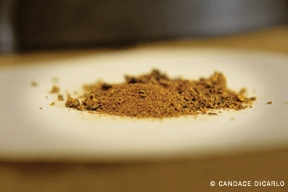
If there’s one thing that puts a crimp in Sam Calagione’s underwear, it’s the Reinheitsgebot. The German Beer Purity Law, as it’s otherwise known, was enacted in Bavaria in 1516. “In essence, the Bavarian government mandated that beer could only be made with water, hops, and barley,” Calagione told the Museum tasting crowd in September. “This was before Louis Pasteur, so yeast wasn’t included in that equation, but it was implied. And now, 99 percent of the commercial beers brewed in the world somewhat reference the Reinheitsgebot.”
When Dogfish Head opened 15 years ago, with the motto “Off-centered stuff for off-centered people,” the Reinheitsgebotdominated not just brewing behemoths like Anheuser-Busch, but the microbrewery scene as well. The notion of using ingredients like pumpkin, chicory, and St. John’s Wort had, to put it mildly, not occurred to most brewers. “We were looked upon as heretics, or freaks, or weirdos—even by some of the folks within our craft-brewing community in that era,” Calagione said. “We were looked upon as untraditional brewers for making beers that didn’t reference the Reinheitsgebot. And our brewery’s opinion is that the Reinheitsgebot is a relatively modern form of art censorship.”
Working with McGovern has strengthened his claim to a deeper brewing tradition. “We did some of these before we met Doctor Pat,” says Calagione. “Him trying one of our Medieval braggots was kind of what got our first conversation going. But when we met, it sort of solidified my belief that our path to convince people to embrace beers beyond the Reinheitsgebot was more backwards-looking than forwards-looking—meaning that long before the Reinheitsgebotexisted, beers around the world were way more colorful. They embraced the local indigenous ingredients of whatever culture they were made within, and there was this breadth of color and diversity.”
The benefits of the partnership have flowed both ways. “For an archaeologist, it gives you a chance to play around with some of the variables in your findings,” says McGovern. “I mean, you think to yourself: I’ve got this ingredient and that ingredient—and sometimes they sound like a combination that would never taste good. That was my original impression with Midas. But [in craft brewers], you have a group of people who are willing to try all kinds of different possibilities to see what might work and make a drinkable beverage—the assumption being that what tastes good to us probably tasted good to our ancestors, since they had a lot of the same sensory apparatus. That’s what really came out of the Midas study: there were ways to make these beverages quite tasty. We still don’t know exactly how they were all made, but at least we’ve got some better idea now.”
In 2004, McGovern and several colleagues published a paper in Proceedings of the National Academy of Sciences detailing an “extreme beverage” that pushed back the clock on human-controlled fermentation all the way to 7000 B.C. To the surprise of many, the organic residues in question this time came not from the Near East, but from a Neolithic Chinese site called Jiahu. They pointed toward a grog made from rice, grapes and/or hawthorn fruit, and honey.
Chateau Jiahu, as Dogfish Head dubbed the second vintage they reconstructed at McGovern’s urging, spills from the bottle in a honey-hued haze scented with chrysanthemum flowers. Its off-dry profile pairs well with spicy food. It’s also probably the only beer on the market to which a shrine has been erected in an academic archaeochemistry lab; McGovern keeps an unopened bottle of it on a side table, with a gold medal from the 2009 Great American Beer Festival draped around its neck.
Yet what really fires McGovern up about the Jiahu grog are some of the other artifacts unearthed from the same site, particularly a suite of about two dozen flutes crafted from a specific bone found in the wing of the red-crowned crane. They have been called the earliest playable musical instruments in the world, with a seven-hole layout capable of generating the same pentatonic scale that characterizes traditional Chinese music today. Some have been found in burial pits interpreted to be the resting places of “musician/shamans.” Additionally, the site has yielded some of the oldest pottery in China, as well as some of the oldest rice. “Jiahu also has, putatively, some of the earliest writing,” McGovern adds.
He believes it’s no coincidence that fermented beverages appear to have predated or accompanied these early cultural flowerings. “The Jiahu musicians were probably much more like our concept of the Paleolithic shamans or their modern Siberian or Amazonian counterparts,” McGovern posits in Uncorking the Past. “Besides being musicians, they would have been the idea men, highly facile with signs and art, technically proficient, and, most important, with a mystical bent, stimulated by a fermented beverage, that brought them into contact with the gods and ancestors.”
When historians and archaeologists talk about the stirrings of civilization, they often use phrases like spiritual ferment and cultural ferment to describe the transformation. For McGovern, fermentation is more than a metaphor.
“The real trump card when it comes to alcoholic beverages, I think, is this mind-altering effect,” he said during his Museum lecture. “And when you couple that with the process of fermentation, which the ancient people wouldn’t have understood but was like a magical thing,” beer and wine start to seem even more consequential. “They would see the carbon dioxide coming off the fermenting beverage, throwing up all sorts of gases, almost like an external spirit at work. They couldn’t see the yeast—that’s microscopic, we’d have to wait for Louis Pasteur for that—but they could see the results.”
With mounting exuberance, he projected a slide of an Iranian jug dating to around 5400 B.C. “This happens to be the most ancient wine vessel that we’ve yet identified chemically,” he went on. “And if you carried out the fermentation in that vessel, you could actually expect it to start to rock back and forth. So it’s like there’s some sort of mysterious force at work! And then you can start to see why people would place fermented beverages right at the center of their cultures. In Judeo-Christian cultures, wine is at the center, but if we look in other places we can see the same thing. Africa, for instance, is a continent awash in fermented beverages. There are millet and sorghum beers, honey mead, banana and palm wines…”
Circling back to Jiahu and playing off McGovern’s contagious zeal, Calagione hopped up to the podium. “There’s a pretty strong school of thought that says the reason we settled down and formed these villages was to watch our grains and crops grow so that we could make beer and fermented beverages,” he said. “So as a brewer, it gives me a lot of pride that as far as I know, our industry is responsible for civilization as we know it.
“That might be argued,” he added in the trough after the crowd’s laughter. “But the fact that this one dig site had not only the oldest fermented beverage, but also the oldest musical instrument that we know of, tells us that this was, like, the original hootenanny.”
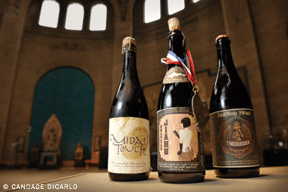
McGovern doesn’t go so far as to credit beer or wine for turning our species of wanderers into a society of farmers. And he allows that alcoholic beverages aren’t quite universal.
“I should say, there are certain parts of the world where humans have not been able to do a fermented beverage, especially the Arctic and Antarctic,” he conceded at the Museum tasting. “Some people say you can take bear fat and ferment that into an alcoholic beverage, but I don’t think so.” There is also little in the archaeological record of North America, for instance, indicating that such beverages played a role here—though they appear to have been widespread in Central and South America, which is something of a conundrum. “These things all go back to earlier times,” says Solomon Katz. “And it’s a matter of time before the empty slots are filled in. It’s sort of like the periodic table of brewing.”
The evidence McGovern has developed from organic residues in old pottery sherds adds to a growing area of inquiry into the ways that cooking, eating, and drinking have shaped human culture and even human biology. Harvard biological anthropologist Robert Wrangham has recently argued that the invention of cooking is responsible for some of the hallmark characteristics of human anatomy. By essentially pre-digesting their food with fire, his thinking goes, our evolutionary ancestors were able to lose the strong jaws and huge digestive tracts that typify our primate cousins (who need them for the energy-intensive task of breaking down raw food), thereby freeing up metabolic resources to fuel a marked expansion of brain function.
Wrangham’s hypothesis has stirred considerable controversy. Physical evidence for the controlled use of fire some 2 million years ago, when these anatomical changes are thought to have taken place, is all but nonexistent. But his emphasis on food-processing, which McGovern shares, has been welcomed by some anthropologists who aren’t ready to swallow Wrangham’s theory whole.
“I always say that the flip side of agriculture is cuisine,” says Solomon Katz. “There’s very little food, with the exception of fruit, that we consume that isn’t highly processed, either by grinding or otherwise. In a sense, we’ve replaced our teeth with our stones.
“In other words, you can’t have agriculture without having a lot of food-processing to go with it. And [fermentation] is just one good example of the kind of food-processing that takes place, but it’s a very important one because it’s primary. From the point of view of being able to control fermentation, even though people didn’t understand exactly what it was, they knew what the end products were. And the end products were good and, it turns out, very healthy.”
Even, perhaps, the ones coaxed toward fermentation by human saliva. This is actually a method that survives today in various traditional cultures. “In remote areas of Japan and Taiwan,” McGovern writes, “you can still find women sitting around a large bowl, masticating and spitting rice juice into the vessel as they prepare the rice wine for a marriage ceremony. In fact, this method of making an alcoholic beverage from a grain spans the globe, from the corn beers or chichas of the Americas to the sorghum and millet beers of Africa.”
McGovern and some others think that such beverages were a big part of what gave wild cereals their initial importance. “Rice, sorghum, millet, wheat, barley, corn —these are the main grains and all of them probably have their origin as fermented beverages, as far as being domesticated is concerned,” he says. “In the case of corn, one of the hypotheses, which I think makes a lot of sense, is that you’ve got this really strange-looking wild specimen called teosinte, which only has a few kernels on it and hardly has any nutritive value and is not very sweet—and you really can’t make a bread from that original teosinte plant. But the stalk of the wild plant has a lot of sugary juice, and just by breaking the stalk you can squeeze out a sugary substance. You can also chew it. There are, in early caves in the Americas, wads of wild corn that was being chewed. Well, once you get out that liquid, you would get natural fermentation probably occurring fairly easily. So that might be the reason they started focusing on that plant, crossing and recrossing it. It took multiple genetic changes to finally get to the corn we’re accustomed to.”
If your palate yearns for a taste of something to which it is thoroughly unaccustomed, Dogfish Head’s Chicha is all gone. But there are still bottles of Chateau Jiahu and Midas Touch floating around, as well as Calagione and McGovern’s 2008 homage to the Aztecs, Theobroma. And while the pair has no current plans for a fifth vintage, there’s no telling where the spirit might move them next.
“Out there in Central Asia, the Mongolian people are lactose intolerant,” McGovern muses among his shelves of chemical vials. “But if you take mare’s milk from horses and you ferment it, you actually change the sugar into a form you can digest. And that’s what they did. It’s called koumiss, and it’s a really important part of their culture …”
He pauses to wonder why so many archaeologists and anthropologists have passed over the history of alcoholic beverages without comment. In the sticky yellow residues and crimson stains others have looked upon as dregs, McGovern sees the markings of a deeper human story. “What I really find amazing is how people have ignored this,” he says. “These drinks reflect how our species has developed on this planet—by taking whatever we can in nature and making it into something really good.”
EXCERPT
From Drunken Monkeys to Medicine Men: A Brief History of Tipsiness
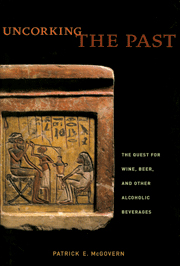
To understand the modern fascination with alcoholic beverages of all kinds, as well as the reasons why they are also targets of condemnation, we need to step back and take a longer view. Alcohol occurs in nature, from the depths of space to the primordial “soup” that may have generated the first life on Earth. Of all known naturally addictive substances, only alcohol is consumed by all fruit-eating animals. It forms part of an intricate web of interrelationships between yeasts, plants, and animals as diverse as the fruit fly, elephant, and human, for their mutual benefit and propagation. According to the “drunken monkey hypothesis,” most primates are physiologically “driven to drink,” and humans, with bodies and metabolisms adapted to the consumption of alcohol, are no exception. Like water, a fermented beverage refreshes and fills us up, but it does much more. Apart from the peoples in the Arctic and those at the southern tip of South America in Tierra del Fuego—dwelling in climates too harsh to support any sugar-rich plants—almost every known culture has produced its own alcoholic beverage. Signs of indigenous fermented drinks are also so far noticeably absent from Australia, perhaps owing to limited excavation there. The use of the hallucinogen pituri by Aborigines may be a later substitution for alcohol, as tobacco might have been for native North Americans.
Beyond the physiological imperative, the universality of fermented beverages in human societies cries out for even farther-reaching explanations. Certainly, the natural occurrence of fermentation, one of the key processes that humans harnessed during their Neolithic revolutions, provides part of the answer. Fermentation contributes nutrients, flavors, and aromas to food and drink—whether a lambic beer, Champagne, cheese, or tofu. It removes potentially harmful alkaloids, helps to preserve them because alcohol kills spoilage microorganisms, and decreases food-preparation time and hence fuel needs by breaking down complex constituents.
Moreover, alcoholic beverages within human cultures effectively transcend the natural process of fermentation. They have a long and widespread history as superb social lubricators. The great monuments of the human civilization—for example, the Egyptian pyramids and the Incan royal centers and irrigation works—were built by rewarding the workers with vast quantities of alcoholic refreshment. Today, fund-raising and political success can hardly be imagined without a liberal supply of drink. On any night in any part of the world you will find people gathered in bars, pubs, and drinking halls, conversing animatedly and relieving the stresses of the day.
Before modern medicines, alcoholic beverages were the universal palliative. The pharmacopeias of ancient Egypt, Mesopotamia, China, Greece, and Rome depended on fermented beverages for treating every kind of ailment. They were also used as vehicles for dissolving and dispensing medicinal herbs, resins, and spices. Past peoples didn’t need science to tell them about alcohol’s antiseptic and antioxidant properties or other benefits that prolonged life and increased reproductive rates. They experienced or observed some of the beneficial effects firsthand.
The psychotropic effects of alcoholic beverages stoked our religious propensities worldwide. Sub-Saharan Africa, where the human odyssey began, is today awash in alcoholic beverages made from honey, sorghum, and millet. Virtually every important religious festival, celebration, or rite of passage—above all, those honoring ancestors—is marked by the presentation and drinking of a fermented beverage. Even in secular Western culture, where drinking alcohol is more of a recreational diversion than a religious passion, people follow distinct protocols in their consumption of the beverages, whether partaking of a favorite beverage at cocktail hour or carefully managing an intake of stimulants to prolong the frenzy of an all-night binge.
The close association between religious practices and alcohol attests to either firmly entrenched biological tendencies or long-established cultural traditions. In other words, investigating the consumption of alcoholic beverages highlights the classic dilemma in studying human society: are certain behaviors more the result of nature or of nurture? Around the world, the available archaeological, chemical, and botanical evidence attests to the close association between alcoholic beverages and religion. Except where alcohol has been proscribed or access to the divine has been achieved in other ways (e.g., through meditation, as in Hinduism and Buddhism), important religious ceremonies often center on an alcoholic beverage. In the West, the wine of the Eucharist is at the heart of Christian religious observances, and every important Jewish ceremony is marked by the drinking of a specific number of glasses of wine.
Other common cultural threads connecting alcoholic beverages and human culture run through my narrative. Some of these strands likely reflect the fact that our species arose in sub-Saharan Africa and then spread out to the rest of the world only about one hundred thousand years ago. Humans everywhere sought sugar-rich, naturally fermenting fruits, honey, grasses, tubers, and other ingredients for fermented beverages. These resources were often combined to make a stronger grog or a drink with more potent medical or psychotropic effects. The earliest inhabited sites in the Middle East, central Asia, China, Europe, Africa, and the Americas are replete with fermentable natural products. Where artwork and artifacts have survived, they support the idea that the preparation and use of fermented beverages during the Palaeolithic period was focused on an authority figure, the “shaman,” who oversaw a community’s religious and social needs. Even in this early period, tight bonds must have existed between fermented beverages, religion, music, dance, and sex. Ocher pigmentation of burials andbones, probably symbolizing blood and sometimes the fermented beverage itself, is widespread. Musical instruments were made from specific bird bones, probably because of the associations with their mating calls, dances, and other unusual and seemingly otherworldly behaviors. People donned the costume of birds such as the crane and danced to the music.
By the Neolithic period, humans around the globe had developed very similar methods of saccharifying the starches in cereals to sugars by chewing or sprouting. All the most widely planted cereals in the world today—wheat, rice, corn, barley, and sorghum—were processed by these methods, and the available evidence suggests that the initial domestication of these grains in the Middle East, Asia, Mexico, and the Sahel of Africa was motivated by a desire to increase alcoholic-beverage production. The extraordinary transformation of the minuscule teosinte into maize is difficult to explain unless humans were initially attracted to the plant’s sweet stalks, ripe for fermentation, and then, over millennia, bred it selectively for larger and sweeter kernels. The methods for making and drinking cereal brews—including early Mesopotamian barley beer, Chinese rice wine, and American corn chicha—were also broadly similar around the world and remain so in many places: ferment a wort in a large, open-mouthed jar, and then drink from the same vessel with a long straw, usually sharing the brew with a group of family or friends. Alcoholic beverages made from sweet fruits, including grape, fig, date, and cacao, probably also prompted the domestication of these plants.
One particularly surprising result from our biomolecular archaeological investigations was the discovery that the earliest-known alcoholic beverages came onto the world scene at about the same time—the early Neolithic period, ca. 7000-8000 B.C.—on either side of Asia. In the West, we find the resinated wines of the northern mountainous region of the Near East; five thousand kilometers away, we find the Jiahu grog of China, made by combining rice, hawthorn fruit, grapes, and honey. I have proposed that ideas and traditions of plant domestication and beverage making must have traveled piecemeal, with other aspects of culture, across the expanses of Central Asia, following a prehistoric predecessor of the Silk Road. But an equally compelling hypothesis that would explain these facts, as well as the emergence of new beverages at so many times and places across the planet, is that humans are by nature both innovative and attracted to fermented drinks. In short, if alcoholic beverages are such an integral part of human life, perhaps we are “programmed” with the urge to make and drink them, without needing to invoke any cultural traditions.
This article is excerpted with permission from Uncorking the Past: The Quest for Wine, Beer, and Other Alcoholic Beverages by Patrick E. McGovern, published by University of California Press.


